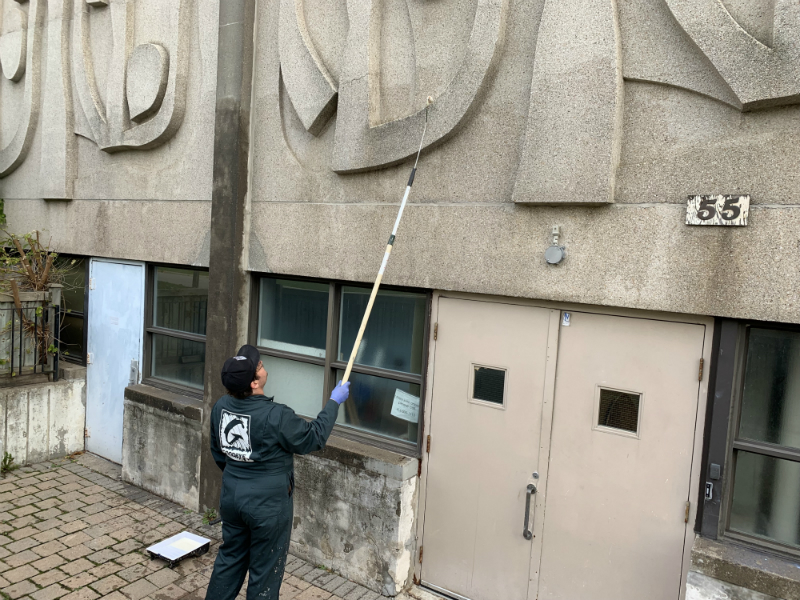“Hang ’em please cuz that zyklon didn’t do the job. The parasite is resistant”; “Hitler was right. We should finish the job.”
These are the types of comments that I’ve been receiving in recent years on YouTube, when I post Yiddish music videos. Unfortunately, it is the new normal for Jewish content online.
YouTube has a convenient “flag” button that allows users to report offensive comments, so they can be quickly removed. But while the vitriolic threats appear gone, what about the people or bots who write these comments? What do we do about them? They could be halfway around the world, or just down the street. And in the wake of the 2018 Tree of Life shooting in Pittsburgh, these threats seem less harmless than they used to.
Recently, I was walking through Toronto’s Bathurst Manor neighbourhood when I saw a van from Goodbye Graffiti parked in front of Beth David Synagogue. My heart sank. Had another shul been vandalized with a swastika? Fortunately, nothing of that sort had occurred. Terence Medugno of Goodbye Graffiti was busy at work with his paint roller applying anti-graffiti coating on the synagogue’s beautifully sculpted exterior.
“With this coating, if they graffiti with a weak spray paint, you can get it off with just a bucket of warm water,” Medugno explained.
It is the real-world equivalent of YouTube’s hate speech removal widget, but when a synagogue is vandalized, we know the perpetrator is somewhere in the neighbourhood. Yet removing the hate speech does not cure the problem and the budget for each preventative coating is steep. Protecting Beth David’s exterior required 15 hours of labour and buckets of specialty coating.
Out of sight, out of mind. At least that’s the intention. But what do we do about people getting up at night to vandalize our buildings? Are we really OK with a society that literally puts a Band-Aid or a coat of paint on hate speech?
The bigger question is, of course, how common is the graffiti problem? It is so prevalent that synagogues across the country are using these types of prevention services. In fact, many measures like this are paid for through the federal government’s Communities at Risk: Security Infrastructure Program (SIP).
SIP provides grants to synagogues, mosques and other vulnerable sites that have been targets of hate crimes. The program helps pay for the costs of security cameras, intercoms, fortified entrances and, yes, anti-graffiti chemicals. It is a two-pronged effort: saving lives through added security and ensuring peace of mind by preventing vandalism.
READ: WHEN KAWHI STUDIED KLEZMER
Rabbis and Jewish community leaders who I spoke with support these efforts.
Andy Pascoe, Beth David’s president, explained that their synagogue recently received a SIP grant to cover 50 per cent of the cost of installing a shatterproof film on all of the glass windows and doors, and to add that anti-graffiti protection.
“We aren’t the only ethnic group being targeted. We want to protect our members, the public and visitors to the building,” he said. “We spent over $20,000 on those two projects.… That’s $10,000 we spent on security that we could have spent on programming.”
I can’t help but ponder how much programming has been sacrificed to minimize vandalism at Canada’s 200-plus synagogues.
Adam Cutler is a rabbi at Toronto’s Adath Israel Synagogue, which was also awarded a SIP grant to upgrade its physical security and install anti-vandalism measures. He elaborated on the need to prevent graffiti and deter would-be attackers who seek media attention. “Having a swastika leading the evening news brings them satisfaction, by letting people know that they were successful in spreading hate,” he said. The SIP program denies the vandals the opportunity to achieve these goals.
Rabbi Yael Splansky, the spiritual leader of Toronto’s Holy Blossom synagogue, reflected on the bigger picture, saying, “I’d rather (the government) invest the money in other ways to prevent hate speech and hateful acts (in the first place), rather then having to (spend) to erase it after the fact.”
Amen to that.
